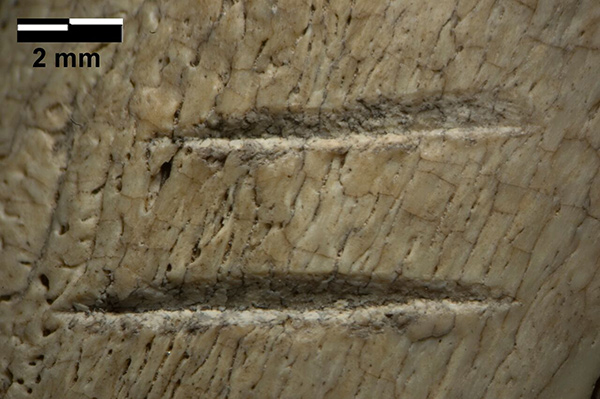Signs from the Stone Age
A sophisticated analysis of ancient bones adds to debate over the human debut of tools--and meat

Courtesy of Jessica Thompson
An Emory anthropologist has developed new methods for digging into two key questions about human evolution: When did we start using stone tools and eating meat?
Here’s the latest: Marks on two 3.4 million-year-old animal bones found at the site of Dikika, Ethiopia, were not caused by trampling, according to an extensive analysis led by Jessica Thompson, assistant professor of anthropology.
“Our analysis clearly shows that the marks on these bones are not characteristic of trampling,” says Thompson, lead author of the study. “The best match we have for the marks, using currently available data, would still be butchery with stone tools.”
So why does this matter? The new findings appear to support a previous conclusion published in Nature in 2010. That finding was sensational, since it potentially pushed back evidence for the use of stone tools, as well as the butchering of large animals, by about eight hundred thousand years. It also has important implications for theories about when we started eating meat. The work sparked a series of debates among scientists about whether the bones could have been trampled instead.
The current study, published in the Journal of Human Evolution, developed new methods of fieldwork and analysis for researchers exploring the origins of tool making and meat eating in our ancestors. Thompson and her coauthors examined the surfaces of a sample of more than four thousand other bones from the same deposits. They then used statistical methods to compare more than 450 marks found on those bones to experimental (or recreated) trampling marks, and to those on the two specimens in question.
The twelve marks on the two specimens—a long bone from a creature the size of a medium antelope, and a rib bone from an animal closer in size to a buffalo—most closely resemble a combination of purposeful cutting and percussion marks, Thompson says.
“We would really like to understand what caused these marks,” she says. “One of the most important questions in human evolution is when we started eating meat, since meat is considered a likely explanation for how we fed the evolution of our big brains.”

Evidence shows that our genus, Homo, emerged around 2.8 million years ago. Until recently, the earliest known stone tools were 2.6 million years old. Changes had already been occurring in the organization of the brains of the human lineage, but after this time there was also an increase in overall brain size. This increased size has largely been attributed to a higher-quality diet. A leading hypothesis in paleoanthropology is that a diet rich in animal protein combined with marrow fat provided the energy needed to fuel the larger human brain. The animal bones in the Dikika site, however, have been reliably dated to long before Homo emerged.
Thompson specializes in the study of what happens to bones after an animal dies.
“Fossil bones can tell you stories, if you know how to interpret them,” she says.
For the recent study, Thompson and her team investigated, with microscopic scrutiny, all non-hominin fossils collected from the Hadar Formation at Dikika. The researchers collected a random sample of fossils from the same deposits as the controversial specimens, as well as nearby deposits. They measured shapes and sizes of marks on the fossil bones. Then they compared the characteristics of the fossil marks statistically to those reported as being typical of trampling damage.
“The random population sample of the fossils provides context,” Thompson says. “Our analysis shows with statistical certainty that the marks on the two bones in question were not caused by trampling. While there is abundant evidence that other bones at the site were damaged
by trampling, these two bones are outliers. The marks on them still more closely resemble marks made by butchering.”
The Dikika specimens represent a turning point in paleoanthropology, Thompson says. Her study was covered by a number of national and international media outlets, including Forbes, Archeology Magazine, Live Science, and the Daily Mail.
“If we want to understand when and how our ancestors started eating meat and moving into that ecological niche, we need to refine our search images for the field and apply these new recovery and analytical methods,” Thompson says. “We know that simple stone tools are not unique to humans, but the making of more complex tools, designed for more complex uses, may be uniquely human.”—Carol Clark



